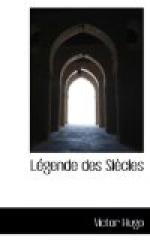This underlying conception was expressed again in the poem entitled La Vision d’ou est sorti ce livre, which was written at Guernsey in 1857, but published only in 1877. In this vision the history of man appears to the poet in the form of a gigantic wall, on which are seen the crimes and sufferings of all the ages. Two spirits pass by, the spirit of Fate (Fatalite), which is the enemy of man, and the spirit of God (Dieu), which is the friend of man. This wall is shivered into fragments, by which the seer understands the destruction of pain and evil, and the closing of the long volume of human history. That volume, the end of which the dreamer foresees, the poet proposes to write:
Ce livre, c’est le reste effrayant
de Babel;
C’est la lugubre Tour des Choses,
l’edifice
Du bien, du mal, des pleurs, des deuils,
des sacrifices,
Fier jadis, dominant les lointains horizons,
Aujourd’hui n’ayant plus que
de hideux troncons
Epars, couches, perdus dans l’obscure
vallee;
C’est l’epopee humaine, apre,
immense—ecroulee.
The poet’s view of the problem of evil and the destiny of humanity becomes clearer if the Legende is read in connexion with the two poems mentioned in the Preface to the volume of 1859, as designed to form with it an immense trilogy: Dieu and La Fin de Satan. Neither was published till after the poet’s death, and the latter was left in an unfinished condition. But they were both planned in the days when, isolated on his rock and severed from active life, the poet meditated on the deep questions of life and death. They were meant to be, the one the prelude, and the other the sequel of his poem of humanity. The leading thought of Dieu is the falseness of all the positive systems of religion which have burdened or inspired humanity, and the truth that
‘Dieu n’a qu’un front: Lumiere; et n’a qu’un nom: Amour,’
though it is only death which will fully reveal that light.
The theme of La Fin de Satan is the final reconciliation of good and evil. As Satan falls from heaven, a feather drops from his wing, and from that feather the Almighty creates the angel Liberty, who is thus the child equally of the spirit of Good and the spirit of Evil; that angel finally brings about the pardon of Satan, when the demon finds that it is impossible for him to live without the presence of the Almighty. Man is endowed with liberty, this child of good and ill, and his spirit hovers therefore ever between the exalted and the mean. So humanity appears to the seer in Dieu:




